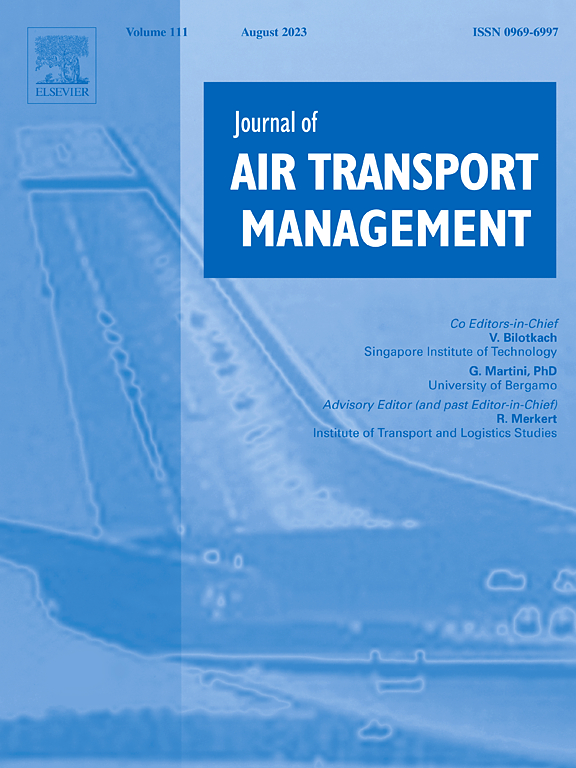Assessing public acceptance of urban air mobility: Behavioral insights
IF 3.6
2区 工程技术
Q2 TRANSPORTATION
引用次数: 0
Abstract
Urban air mobility (UAM) integrates autonomy, electrification, and sharing technologies into air travel with the prospect of connected multimodal transportation systems. Despite technological advances, public acceptance is identified in the literature to be a potential barrier to the widespread UAM deployment in the early stages and its sustainable long-run growth. Here, we investigate whether and what population cohorts embrace UAM as a travel mode to get to an airport by collecting a stated preferences sample dataset in Chicago. A hybrid choice model is then estimated, which accounts for latent or taste heterogeneity in the UAM acceptance behavior, to identify heterogeneous cohorts of UAM (non)users by their (un)observable characteristics and traits. The results provide behavioral and strategic insights that can inform stakeholders and policy makers. Notably, the propensity for UAM is found to be promoted by utilitarian and hedonic beliefs, hindered by acrophobia, and unassociated with safety and security concerns, environmental concerns, and perception of transportation-related benefits. The statistical insignificance of complementary ground access to UAM vertiports can inform strategic infrastructure investment decisions on locating vertiports, specifically by discouraging investments in establishing vertiports in Chicago North Side and downtown. By estimating the model in the willingness-to-pay space, the value of time (hours/$) for UAM, ridehail, rail, and car are directly measured at 72.736, 42.929, 16.268, and 12.357, respectively.
评估公众对城市空中交通的接受程度:行为洞察
城市空中交通(UAM)将自动驾驶、电气化和共享技术整合到航空旅行中,并有望实现互联的多式联运系统。尽管技术进步,但在文献中,公众接受度被认为是早期广泛部署UAM及其可持续长期增长的潜在障碍。在这里,我们通过收集芝加哥的陈述偏好样本数据集,调查人群是否以及哪些人群将UAM作为前往机场的旅行模式。然后估计了一个混合选择模型,该模型考虑了UAM接受行为的潜在或味道异质性,通过UAM(非)用户的(不可观察的)特征和特征来识别异质队列。研究结果为利益相关者和政策制定者提供了行为和战略见解。值得注意的是,UAM的倾向被发现受到功利主义和享乐主义信仰的促进,受到恐高症的阻碍,与安全和保障问题、环境问题和交通相关利益的感知无关。UAM垂直机场的互补地面通道在统计上的不显著性可以为定位垂直机场的战略基础设施投资决策提供信息,特别是通过阻止在芝加哥北部和市中心建立垂直机场的投资。通过在支付意愿空间中估算模型,直接测算出UAM、拼车、铁路和汽车的时间价值(小时/美元)分别为72.736、42.929、16.268和12.357。
本文章由计算机程序翻译,如有差异,请以英文原文为准。
求助全文
约1分钟内获得全文
求助全文
来源期刊

Journal of Air Transport Management
TRANSPORTATION-
CiteScore
12.40
自引率
11.70%
发文量
97
期刊介绍:
The Journal of Air Transport Management (JATM) sets out to address, through high quality research articles and authoritative commentary, the major economic, management and policy issues facing the air transport industry today. It offers practitioners and academics an international and dynamic forum for analysis and discussion of these issues, linking research and practice and stimulating interaction between the two. The refereed papers in the journal cover all the major sectors of the industry (airlines, airports, air traffic management) as well as related areas such as tourism management and logistics. Papers are blind reviewed, normally by two referees, chosen for their specialist knowledge. The journal provides independent, original and rigorous analysis in the areas of: • Policy, regulation and law • Strategy • Operations • Marketing • Economics and finance • Sustainability
 求助内容:
求助内容: 应助结果提醒方式:
应助结果提醒方式:


